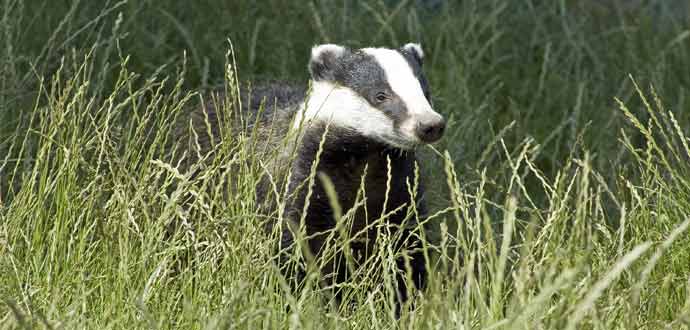
Badgers
With their distinctive black and white faces, Badgers are one of the most recognisable of our native mammals and yet they are rarely seen. These elusive creatures are protected by the Protection of Badgers Act 1992 which makes it an offence to wilfully kill, injure or take a badger, destroy a sett or disturb a badger whilst occupying a sett.
Unlike Foxes, Badgers rarely colonise city gardens so unless you already have Badgers visiting your property, you are unlikely to attract them.

Encouraging Badgers in your garden.
Badgers are generally nocturnal and most often seen after dark snuffling for earthworms. This activity tends to be most successful in areas of short grass which is why a neatly manicured lawn will encourage Badgers to visit your garden if they are in the area. It's worth leaving an area of rough grass too as this will provide cover for other prey such as mice and voles, and also provide an area of cover for the badgers themselves.
Although worms make up a large proportion of their diet, Badgers are omnivorous, eating both meat and plants. As foragers, they eat what is available at the time and this may include insects, birds, amphibians, fruits and berries. Badger watchers will often report that they have a taste for unsalted peanuts too!
If you have badgers in your area, try plant fruit trees and shrubs to provide a food supply in your garden. Apple, Pear, Elder, Crab Apple, Hazel, Rowan, Blackberries and Wild Cherry will all provide an excellent source of food. In larger gardens a mature oak tree is useful for it acorns which are a valuable food source in autumn.
Planting dense rough cover such as brambles, Hawthorn and Blackthorn near to known setts will provide excellent shelter and privacy for Badgers.
Badgers prefer to make their setts in secluded areas with sandy soils rather than heavy clay as lighter soils are easier to dig. They seem to prefer digging setts into slopes as these are well drained and therefore likely to be drier and warmer in winter.
Badgers live in social groups consisting of around 5 adults. Although they do not hibernate, they are generally less active during the winter months. Their cubs are born in January and February but don?t emerge from underground until April or May.
If you are lucky enough to have badgers in your area then it is best to appreciate them from a distance and avoid feeding them directly. Be sure to avoid disturbing the setts as regular visits or disturbances to an inhabited sett may cause badgers to find an alternative, quieter site.
For information on how encourage birds, native wildlife and pollinators to your garden, visit our wildlife hub page.
Quick Links:

Fruiting plants such as blackberries provide an excellent source of badger food.
Sign Up For Exclusive Special Offers




© 2024 Thompson & Morgan. All rights reserved. A division of Branded Garden Products Limited.




